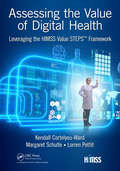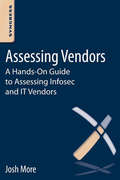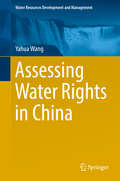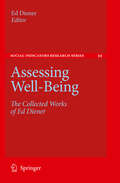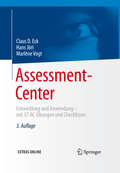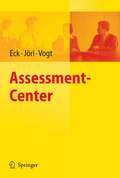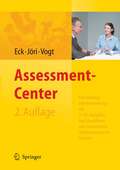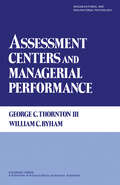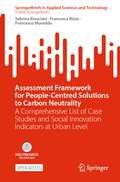- Table View
- List View
Assessing the Value of Digital Health: Leveraging the HIMSS Value STEPS™ Framework (HIMSS Book Series)
by Kendall Cortelyou-Ward Margaret Schulte Lorren PettitHIMSS set out to develop a dynamic framework by which to easily catalogue the varied beneficial evidences of digital health. From this effort, HIMSS introduced to the market the HIMSS Value STEPS™ framework. This book will leverage the HIMSS Value STEPS™ model to identify and define the expressions of value the use of health IT systems can yield per the following domains: Satisfaction, Treatment/Clinical, Electronic Secure Data, Patient Engagement and Population Health, and Savings. Using this framework, HIMSS has developed a collection of over 2,000 cases reflecting the value that hospitals, health systems and other providers have experienced following implementation of their electronic health record and/or other IT-related applications. The more than 17,000 value statements that have been extracted from the 2,000+ case articles have been classified within 85 Standard Value Standard (SVS) within the five STEPS domains. The book will describe the STEPS model to demonstrate the impact of health IT in healthcare organizations, and the quality of care and overall financial and operational performance improvements that have been achieved.
Assessing Vendors: A Hands-On Guide to Assessing Infosec and IT Vendors
by Josh MoreAssessing vendors is a tricky process. Large and regulated organizations are forced to demonstrate due diligence in vendor assessment, but often do not know how to do this. This results in a great deal of busywork being required by both the vendors and the organizations. Smaller organizations don't know what to look for and, as a result, often wind up selecting based on price instead of value. This results in service failures and vendors that just milk their customers for as long as they can. Assessing Vendors shows you how to walk the line between under- and over-assessing, so decisions can be made on sufficient data without wasting time, digging too deeply, or making decisions too quickly. This hands-on guide will show you how to use an iterative approach to vendor analysis, so you can rapidly filter out the vendors that are clear failures and then select likely winners. It will then show you how to do progressively deeper dives into the likely winners so you can select a preferred vendor. Finally, you will learn how to negotiate with your preferred vendor to get reasonable prices and services. Provides an iterative approach to vendor assessment, showing you how to make decisions on sufficient data without wasting time Includes checklists to help you navigate the decision-making process, while considering all the important factors needed to make a sound decision Helps you understand and evaluate vendors based on key concepts such as performance criteria, functional testing, production, and priceProvides an iterative approach to vendor assessment, showing you how to make decisions on sufficient data without wasting timeIncludes checklists to help you navigate the decision-making process, while considering all the important factors needed to make a sound decisionHelps you understand and evaluate vendors based on key concepts such as performance criteria, functional testing, production, and price
Assessing Water Rights in China (Water Resources Development and Management)
by Yahua WangThis book presents a model for describing the hierarchical concept of China’s water rights structure, one which takes into account pioneering theories on natural resources and environmental institutional economics. It highlights the basic theory of water rights, with a view to helping Chinese policymakers acquire a deeper understanding of water rights and the need for a reform program in the long-term development of water-poor China. To do so, it draws on three main sources: Cheung SNS’s “Economic Explanation”, Douglas C. North’s “New Economic History” and Ray Huang’s “Macro History”.The book makes two essential contributions: it elaborates the hierarchical water governance structure in China, which originated in the Qin Dynasty that unified the country 2000 years ago and has been employed without interruption ever since; further, it constructs a choice model for water governance structures and advances the logic of making structural choices with minimum transaction costs under constraint conditions, while also explaining the inherent nature of China’s choice for the hierarchical structure from the perspectives of management cost and cooperation cost. As such, the book enriches and builds on the theories of the “water governance” school represented by Karl Marx, Karl Wittfogel and Ray Huang, laying the foundation for the further study of water rights theory in contemporary China.
Assessing Well-Being: The Collected Works of Ed Diener (Social Indicators Research Series #39)
by Ed DienerThe Sandvik, Diener, and Seidlitz (1993) paper is another that has received widespread attention because it documented the fact that self-report well-being scales correlate with a number of other methods of measuring the same concepts, such as with reports by knowledgeable “informants” (family and friends), expe- ence sampling measurement, and the memory for good versus bad life events. A single factor was found to underlie measures using different methods, and a n- ber of different well-being self-report measures were found to correlate with the non-self-report measures. Thus, although the self-report measures of well-being are imperfect, and can be in uenced by response artifacts, they have substantial validity as shown by their correlations with measurements based on alternative methods. Whereas the Pavot and Diener article reviewed the Satisfaction with Life Scale, the Lucas, Diener, and Larsen (2003) paper reviews various approaches to assessing positive emotions. As we wrote in the chapter in this volume in which we present new measures, we do not consider any of the existing measures of positive affect to be entirely acceptable for measuring subjective well-being in the affect area, and that is why we have created and validated a new measure.
Assessment and Development Centres
by Iain Ballantyne Nigel PovahSince the first edition of this book, the level of interest and the varied forms of assessment and development centres have mushroomed. Iain Ballantyne and Nigel Povah's book looks at the entire process, from the underlying concepts to the most effective methods of validation - not forgetting the organizational politics involved. The main objectives of the book are: ¢ to establish a thorough understanding of the principles and practice of assessment and development centres; ¢ to provide sufficient knowledge to enable practitioners to run their own events in a professional manner; ¢ to help readers to recognise when they may need to call on outside expertise, and ¢ to equip readers to ask pertinent questions of any prospective advisers. This second edition includes guidance to reflect the significant developments within the technology, along with further advice on quality control, process improvements and further refinements to the increasingly popular development centre concept. Assessment and Development Centres represents a practical approach which is sure of a warm welcome from HR professionals.
Assessment and Development Centres
by Iain Ballantyne Nigel PovahSince the first edition of this book, the level of interest and the varied forms of assessment and development centres have mushroomed. Iain Ballantyne and Nigel Povah's book looks at the entire process, from the underlying concepts to the most effective methods of validation - not forgetting the organizational politics involved. The main objectives of the book are: ¢ to establish a thorough understanding of the principles and practice of assessment and development centres; ¢ to provide sufficient knowledge to enable practitioners to run their own events in a professional manner; ¢ to help readers to recognise when they may need to call on outside expertise, and ¢ to equip readers to ask pertinent questions of any prospective advisers. This second edition includes guidance to reflect the significant developments within the technology, along with further advice on quality control, process improvements and further refinements to the increasingly popular development centre concept. Assessment and Development Centres represents a practical approach which is sure of a warm welcome from HR professionals.
Assessment and Diagnosis for Organization Development: Powerful Tools and Perspectives for the OD Practitioner
by William J Rothwell Angela L.M. Stopper Jennifer L. MyersAlthough the theory and methods of organization development (OD) assessment and diagnosis have been covered in other books, there is a lack of practitioner-focused guides that introduce real-world case studies and tools rooted in the methodology. This book will fill that gap, providing practical perspective and insight from practitioners and consultants currently practicing OD assessment and diagnosis. Organization Development (OD) differs from management consulting in that OD assessment and diagnosis is not a prescriptive consulting engagement. Instead, OD methods include engaging clients to build change leadership initiatives customized to their particular situation. OD is not about a consultant telling a client company what to do. It is about an OD professional guiding client companies on their journey towards the best end point for their particular situation. This book will address that journey. The theory and foundational principles of OD are covered, but the primary focus is on providing practical applications to businesses. While the book is grounded in sound academic theory, its strength is its practitioner-focused methodology containing vignettes and tools that individuals can use to help guide the assessment and diagnosis efforts in their own or their client organizations.
Assessment and Diagnosis for Organization Development: Powerful Tools and Perspectives for the OD Practitioner
by William J Rothwell Angela L.M. Stopper Jennifer L. MyersAlthough the theory and methods of organization development (OD) assessment and diagnosis have been covered in other books, there is a lack of practitioner-focused guides that introduce real-world case studies and tools rooted in the methodology. This book will fill that gap, providing practical perspective and insight from practitioners and consultants currently practicing OD assessment and diagnosis. Organization Development (OD) differs from management consulting in that OD assessment and diagnosis is not a prescriptive consulting engagement. Instead, OD methods include engaging clients to build change leadership initiatives customized to their particular situation. OD is not about a consultant telling a client company what to do. It is about an OD professional guiding client companies on their journey towards the best end point for their particular situation. This book will address that journey. The theory and foundational principles of OD are covered, but the primary focus is on providing practical applications to businesses. While the book is grounded in sound academic theory, its strength is its practitioner-focused methodology containing vignettes and tools that individuals can use to help guide the assessment and diagnosis efforts in their own or their client organizations.
Assessment-Center: Entwicklung und Anwendung – mit 57 AC-Übungen und Checklisten
by Claus D. Eck Hans Jöri Marlène VogtAC-Experten zeigen in diesem praxisnahen Buch, wie man Assessment-Center professionell, kreativ, sozialverträglich und gleichzeitig kosteneffizient und flexibel gestaltet und durchführt – im Einsatzgebiet Personalentwicklung ebenso wie in der Personalauswahl. Neben Grundsätzlichem zur Personaldiagnostik, -beratung und Personenbeurteilung bietet das Buch konkrete Anleitungen zur Konstruktion, Durchführung und Evaluation von ACs in der Praxis. Dabei werden diverse AC-Varianten vorgestellt (Einzel-Assessment, Gruppen-Assessment, 360˚-Feedback) sowie Tipps zur Anbindung an die Unternehmensstrategie gegeben. Zahlreiche Ablaufpläne, Checklisten und Übungen finden sich nicht nur im Buch sondern auch zum Download und eigener Bearbeitung im Internet. Ein Werkzeugkasten für Personalentwickler, Personalmanager, Berater und Führungskräfte.
Assessment-Center
by Claus D. Eck Hans Jöri Marlène VogtDas Assessment Center (AC) ist eine der bekanntesten Methoden zur Personalauswahl und -entwicklung. Damit das AC sein Potenzial voll entfalten kann, bieten hier erfahrene AC-Praktiker die fundierte Anleitung für den Entwurf und die Durchführung inkl. Ablaufpläne und Checklisten. Sie beurteilen Varianten, Weiterentwicklungen und Trends. Sie zeigen Maßnahmen zur Prüfung der Wirksamkeit und Anbindung an die Unternehmensstrategie. Eine praktisch nutzbare und inhaltlich fundierte Praxis- und Orientierungshilfe für Anwender und Entscheider, die ACs kosteneffizient durchführen und sich dennoch an wissenschaftlichen Standards orientieren wollen.
Assessment Center: Entwicklung, Durchführung, Trends Mit neuen originalen AC-Übungen
by Christof ObermannDieses Standardwerk vermittelt neue und immer noch gültige Erkenntnisse aus der empirischen Forschung und aus der Praxis für die betriebliche Anwendung. Das Buch gibt konkrete Anleitungen zur Entwicklung eines unternehmensspezifischen Assessment Centers und behandelt auch neue Entwicklungen und Trends. Mit zwei originalen AC-Übungen: Rollenübungen für ein Mitarbeitergespräch und Postkorb-Fallstudie, inklusive Musterlösung und Auswertung.Jetzt mit noch mehr praktischen HInweisen in der 4., vollständig überarbeiteten Auflage mit über 500 Seiten sowie mehr als 80 Skizzen und Abbildungen.
Assessment Center: Entwicklung, Durchführung, Trends Mit originalen AC-Übungen
by Christof ObermannDieses Standardwerk vermittelt neue und immer noch gültige Erkenntnisse aus der empirischen Forschung und aus der Praxis für die betriebliche Anwendung. Das Buch gibt konkrete Anleitungen zur Entwicklung eines unternehmensspezifischen Assessment Centers und behandelt auch neue Entwicklungen und Trends. Mit zwei originalen AC-Übungen: Rollenübungen für ein Mitarbeitergespräch und Postkorb-Fallstudie, inklusive Musterlösung und Auswertung.Jetzt mit noch mehr praktischen HInweisen in der 4., vollständig überarbeiteten Auflage mit über 500 Seiten sowie mehr als 80 Skizzen und Abbildungen.
Assessment Center: Entwicklung, Durchführung, Trends. Mit originalen AC-Übungen
by Christof ObermannDieses Standardwerk vermittelt neue und immer noch gültige Erkenntnisse aus der empirischen Forschung und aus der Praxis für die betriebliche Anwendung. Das Buch gibt konkrete Anleitungen zur Entwicklung eines unternehmensspezifischen Assessment Centers und behandelt auch neue Entwicklungen und Trends. Mit zwei originalen AC-Übungen: Rollenübungen für ein Mitarbeitergespräch und Postkorb-Fallstudie, inklusive Musterlösung und Auswertung. Jetzt mit noch mehr praktischen HInweisen in der 4., vollständig überarbeiteten Auflage mit über 500 Seiten sowie mehr als 80 Skizzen und Abbildungen.
Assessment Center: Entwicklung, Durchführung, Trends. Mit originalen AC-Übungen
by Christof ObermannDer Autor hat die neuen und die immer noch gültigen Erkenntnisse aus der empirischen Forschung und der Praxis für die betriebliche Anwendung mit mehr als 80 Skizzen und Abbildungen anschaulich aufbereitet. Das Standardwerk zum Assessment Center nun in der dritten, komplett überarbeiteten Auflage mit noch mehr praktischen Hinweisen.
Assessment Center
by Christof Obermann Obermann Consulting GmbHKonzentrierte Praxiserfahrungen werden hier umsetzbar und kritisch dargestellt. Das Buch gibt konkrete Anleitungen zur Entwicklung eines unternehmensspezifischen Assessment Centers und behandelt auch neue Entwicklungen und Trends wie Einzelassessments, computergestützte Anwendungen, dynamische Assessments.
Assessment-Center. Entwicklung und Anwendung - mit 57 AC-Übungen und Checklisten zum Downloaden und Bearbeiten im Internet: Entwicklung Und Anwendung - Mit 57 Ac-aufgaben Und Checklisten Zum Downloaden Und Bearbeiten Im Internet
by Claus D. Eck Hans Jöri Marlène VogtDas Assessment-Center (AC) dient hauptsächlich der Personalauswahl, wird aber auch im Rahmen der Personalentwicklung eingesetzt. In dem Band zeigen erfahrene AC-Praktiker, wie ein Assessment-Center konstruiert und durchgeführt werden kann – kosteneffizient und unter Einhaltung wissenschaftlicher Standards. Sie erläutern Maßnahmen zur Prüfung der Wirksamkeit des Assessment-Centers und zu dessen Anbindung an die Unternehmensstrategie. Ablaufpläne, Checklisten und Übungen werden in der 2. Auflage zum Downloaden und Bearbeiten angeboten.
Assessment Center Training für Dummies (Für Dummies)
by Laura Lüneborg Pia Petruschke Katharina RothHerzlichen Glückwunsch! Sie haben eine Einladung zu einem Assessment Center erhalten und damit die erste Hürde im Bewerbungsverfahren genommen. Nun ist es an Ihnen, sich planvoll vorzubereiten, um die vielfältigen, standardisierten Aufgaben zu bestehen. Pia Petruschke, Laura Lüneborg und Katharina Roth helfen Ihnen dabei. Sie erläutern Ziele und Absichten sowie den Aufbau eines Assessment Centers, nennen die Aufgabe der Beobachter, beschreiben die Methoden und geben Ihnen wertvolle Tipps für die Vorbereitung auf das Interview, die Präsentation und Diskussion, das Rollenspiel sowie die Gruppenübung. Auch die Materialschlachten rund um die Postkorbübung und die Fallstudien sowie Fähigkeits- und Persönlichkeitstests verlieren nach einer optimalen Vorbereitung ihren Schrecken. So können Sie bestens gebrieft und gelassen den diversen Aufgaben eines Assessment Centers entgegensehen.
Assessment Center und Risikomanagement bei Personalentscheidungen: Leitfaden zur Anwendung
by Florian SchuhmacherWie lässt sich die Güte der Personalauswahl und Potenzialermittlung absichern? Wie kann das damit verbundene unternehmerische Risiko beherrscht werden? Welche Möglichkeiten einer ganzheitlichen Personaldiagnostik gibt es? Assessment Center haben sich als bewährte Verfahren etabliert, wenngleich sie aufwändig sind. In der 2., vollständig überarbeiteten und erweiterten Auflage zeigt der Personalexperte Florian Schuhmacher übersichtlich und mit kritischer Würdigung auf, wie sich Assessment Center effektiv planen, durchführen und nachbereiten lassen und wie deren Ergebnisse in andere personalwirtschaftliche Disziplinen einfließen können. Als Weiterentwicklung der AC-Methode wird das Assessment Center-Interview vorgestellt, das als AC-Light in den Situationen einsetzbar ist, in denen bisher klassische Interviewformen dominiert haben. Mit hilfreichen Checklisten und Handlungsempfehlungen, auch zu Aspekten der Internationalisierung und Globalisierung.
Assessment Centers and Managerial Performance (Organizational and Occupational Psychology)
by George C. Thornton III William C. ByhamAssessment Centers and Managerial Performance presents the historical development of multiple assessment procedures with focus on those advances relevant to assessment centers. This book discusses the models of job analysis, the nature of managerial work, work-sampling assessment methods, and the process of human judgment based on the assessment center experience. Organized into 11 chapters, this book begins with an overview of the various methods to describe, evaluate, and predict management effectiveness. This text then describes a number of assessment programs, including the earliest assessment centers. Other chapters consider the five approaches to predicting managerial effectiveness, including psychometric testing, clinical evaluations by psychologists, supervisor's ratings of potentials background interviews, and assessment centers. This book discusses as well the three levels of managerial jobs, namely, supervisory, middle management, and executive. The final chapter deals with the development of standards for assessment center operations. This book is a valuable resource for psychologists.
Assessment Centre Success: Your Ultimate Resource of Practice Exercises and Sample Questions to Help you Ace the Activities, Beat the Competition and Impress Employers
by Tony WeightmanAssessment Centre Success is your road map to mastering the skills, exercises and challenges that you'll be faced with when trying to secure that prized job offer. An Assessment Centre can be daunting: you are likely to face a full day of challenging exercises, tests and skilled competitors. However, with the right level of practice and preparation, you will be able to confidently tackle whatever employers may throw at you.Written by experienced Assessment Centre planner, Tony Weightman, Assessment Centre Success contains a bank of practice exercises and insider tips to help you succeed. Individual exercises are covered, including how to deliver good presentations, reports, interviews and analysis under pressure as well as group exercises such as problem solving and team presentations. Expert guidance on how to demonstrate the key skills employers are looking for helps you understand how to show yourself in the best possible light under challenging circumstances: including leadership, team work, industry knowledge, keeping calm under pressure, decision making, analytical skills, confidence and communication skills.
Assessment Centre Success: Your Ultimate Resource of Practice Exercises and Sample Questions to Help you Ace the Activities, Beat the Competition and Impress Employers
by Tony WeightmanAssessment Centre Success is your road map to mastering the skills, exercises and challenges that you'll be faced with when trying to secure that prized job offer. An Assessment Centre can be daunting: you are likely to face a full day of challenging exercises, tests and skilled competitors. However, with the right level of practice and preparation, you will be able to confidently tackle whatever employers may throw at you.Written by experienced Assessment Centre planner, Tony Weightman, Assessment Centre Success contains a bank of practice exercises and insider tips to help you succeed. Individual exercises are covered, including how to deliver good presentations, reports, interviews and analysis under pressure as well as group exercises such as problem solving and team presentations. Expert guidance on how to demonstrate the key skills employers are looking for helps you understand how to show yourself in the best possible light under challenging circumstances: including leadership, team work, industry knowledge, keeping calm under pressure, decision making, analytical skills, confidence and communication skills.
Assessment Centres and Global Talent Management
by George C. IiiGlobalization, innovation, market share, identifying visionary leaders and, particularly, talent management ...are just some of the issues that benefit from using assessment and development centres. Assessment Centres and Global Talent Management focuses on topics that influence the design of the assessment centre in terms of the competencies being assessed, the exercises that are used and the nature of the event, so that they can deliver what is required; often to change organizational culture and values. Practical examples and case studies are sprinkled throughout the book as international contributors explore cross-cultural implications, and consider how the design, development and use of assessment centres should be adapted to different cultures. Some of the world's leading researchers and practitioners outline their research into new applications for assessment centre methods, showing how they have used it to design and implement specific assessment and development centres. This is a book from which practitioners can see how science informs good practice, and scholars will find the 32 chapters a rich source of ideas for conducting research into emerging issues in the field.
Assessment Centres and Global Talent Management
by George C. IiiGlobalization, innovation, market share, identifying visionary leaders and, particularly, talent management ...are just some of the issues that benefit from using assessment and development centres. Assessment Centres and Global Talent Management focuses on topics that influence the design of the assessment centre in terms of the competencies being assessed, the exercises that are used and the nature of the event, so that they can deliver what is required; often to change organizational culture and values. Practical examples and case studies are sprinkled throughout the book as international contributors explore cross-cultural implications, and consider how the design, development and use of assessment centres should be adapted to different cultures. Some of the world's leading researchers and practitioners outline their research into new applications for assessment centre methods, showing how they have used it to design and implement specific assessment and development centres. This is a book from which practitioners can see how science informs good practice, and scholars will find the 32 chapters a rich source of ideas for conducting research into emerging issues in the field.
Assessment Framework for People-Centred Solutions to Carbon Neutrality: A Comprehensive List of Case Studies and Social Innovation Indicators at Urban Level (SpringerBriefs in Applied Sciences and Technology)
by Sabrina Bresciani Francesca Rizzo Francesco MuredduThis open access book presents a catalogue of over one thousand indicators which can be used by cities' public administrators to monitor and evaluate social innovation action plans to support people-centred, collaborative or co-designed solutions to lower carbon emissions. Indicators are clustered according to a framework of social innovation solutions for climate neutrality at city level, developed by merging top-down academic knowledge with bottom-up pragmatic case studies. There is currently limited guidance on how to embed social innovations in their cities’ action plans with the aim of reaching climate neutrality, and on how to assess the progress and impacts of such people-centred projects in cities. The book addresses this gap and is thus relevant for scholars in the field of policy-making and design, as well as cities’ transition teams, policymakers and consultants. Based on the work developed within the EU-funded project NetZeroCities, intervention logics are provided for each of the ten categories of action, with related indicators clustered by category and evaluation criteria (effectiveness, efficiency, relevance, replicability, and scalability). Guidelines to implement the framework support city administrators in defining steps they need to follow to apply the indicators to their local case, making social innovation a crucial lever for accelerating systemic transformation.
